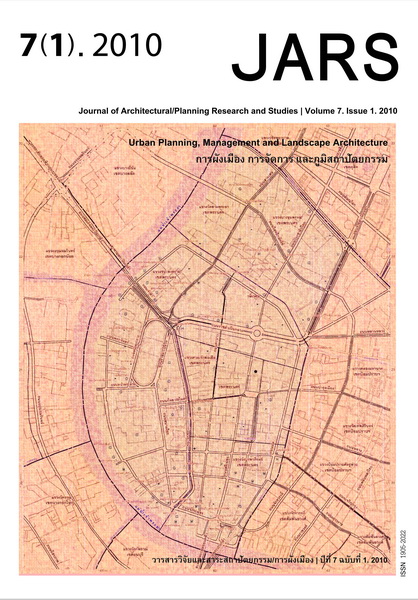Drawing Embodied Spatial Networks in Parallel with Sustainability of Place
Main Article Content
Abstract
With connectivity, we as human beings can sustain in place we live in due to potentials for interlinks and
exchanges with others. In this context, spatial networks, physical organizational fabrics of potential links
between human nodes in living systems (Salingaros, 2005, p. 11-13) and sustainable constructs of place can
be integrated out of embodiment as localization. This paper aims to re-investigate the relationships between
theoretical grounds in an interdisciplinary way that bridge spatial networking and sustainability of place-making.
The review focuses on examining discursive relationships in which the courses of connective modes and
interconnected potentials intersect with the subjects of sustainable concerns towards place-making. This matrix
relationship determines an argument that sustainable places need systematic, integral potentials of experiential
interconnectivity between life-relational environments through which embodied inbetween networks—that
human interactions engage with spatial connective forms—create associative, social realms and collective
identity of place. Logical, embodied networks of place enable to identify inbetween modes of place networks
and lend themselves to form meaningful, organized spatial configurations in place creation. By which a domain
can be bonded as well as retains aesthetics of living survival by means of inbetween modes, potentials of
embodied environmental networks thus contribute a place to be as interconnected, living, and sustainable as a
systemic entity.
Downloads
Article Details

This work is licensed under a Creative Commons Attribution-NonCommercial-NoDerivatives 4.0 International License.
All material is licensed under the terms of the Creative Commons Attribution 4.0 International (CC-BY-NC-ND 4.0) License, unless otherwise stated. As such, authors are free to share, copy, and redistribute the material in any medium or format. The authors must give appropriate credit, provide a link to the license, and indicate if changes were made. The authors may do so in any reasonable manner, but not in any way that suggests the licensor endorses you or your use. The authors may not use the material for commercial purposes. If the authors remix, transform, or build upon the material, they may not distribute the modified material, unless permission is obtained from JARS. Final, accepted versions of the paper may be posted on third party repositories, provided appropriate acknowledgement to the original source is clearly noted.
References
Alexander, C., Ishikawa, S., & Silverstein, M. (1977). A pattern language. New York: Oxford University Press.
Barrie, T. (1996). Spiritual path, sacred place: Myth, ritual, and meaning in architecture. Boston: Shambhala.
Bloomer, K., & Moore, C. (1977.) Body, memory and architecture. New Haven, CT: Yale University Press.
Buchanan, M. (2002). Nexus: Small worlds and the groundbreaking science of networks. New York: W.W. Norton & Company.
Downing, F., Nanda, U., Laiprakobsup, N., & Mohajeri, S. (2008). An embodied architecture. ARCC Journal (Architectural Research Centers Consortium), 5(1), 16-25. Retrieved July 12, 2009, from www.arccweb.org/journal
Gehl, J. (1987). Life between buildings; Using public space. New York: Van Nostrand Reinhold.
Hester, R. (2006). Design for ecological democracy. Cambridge: The MIT Press.
Hillier, B., & Hanson, J. (1984). The social logic of space. Cambridge: Cambridge University Press.
Hillier, B. (1996). Space is the machine. Cambridge: Cambridge University Press.
Kleinsasser, W. (1999). Synthesis 9: A theory base for architecture. Unpublished course manuscript, Department of Architecture. Eugene, OR: University of Oregon.
Knox, P., & Mayer, H. (2009). Small town sustainability: Economic, social, and environmental innovation. Germany: Birkhauser Verlag AG.
Laiprakobsup, N. (2007). Inbetween place: The emergence of the essence, dissertation. College Station, TX: Texas A & M University.
Laiprakobsup, N. (2008). Inbetween place: The emergence of the essence. Berlin, Germany: VDM Publishing House.
Lakoff, G., & Johnson, M. (1999). Philosophy in the flesh: The embodied mind and its challenge to western thought. New York: Basic Books.
Langer, S. (1953). Feeling and form; A theory of art developed from philosophy in a new key. New York, Charles Scribner’s Sons.
Lynch, K. (2000). The image of the city, 27th printing. Cambridge: MIT Press.
Moore, S. (2001). Technology and place: Sustainable architecture and the blueprint farm. Austin, TX: The University of Texas press.
Rapoport, A. (2005). Culture, architecture, and design. Chicago: Locke Science Publishing Company.
Relph, E. (1976). Place and placelessness. London: Pion Limited.
Salingaros, N. (2005). Principles of urban structure. Amsterdam, The Netherlands: Techne Press.
Sassi, P. (2006). Strategies for sustainable architecture. Oxford: Taylor & Francis.
Smithson, A. (Ed.). (1968). Team 10 Primer. Cambridge: MIT Press.
William, D. (2007). Sustainable design: Ecology, architecture, and planning. Hoboken, NJ: Willey Academy.
Williamson, T., Radford, A., & Bennetts, H. (2003). Understanding sustainable architecture. London: Spon Press.
Yeang, K. (2006). Ecodesign: A manual in ecological design. Great Britain: John Wiley & Sons.


